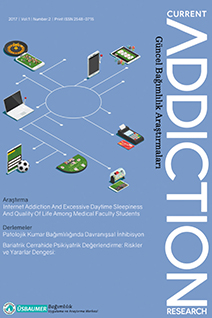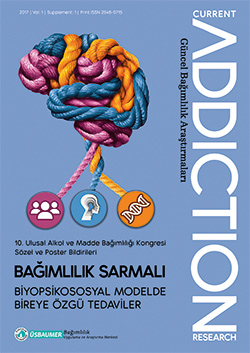Years
2020
2018
Categories
Authors
ARTICLES
Original Article
Sema AKKOYUN,Işıl GÖĞCEGÖZ
2020, 4(2), s:47-53
Original Article
Evaluation of the Factors Predicting Risky Alcohol Use in University Students
Deniz Eryılmaz,Işıl Gogcegoz,Gul Eryılmaz
2020, 4(1), s:16-20
problem in terms of mental health of the individuals and society. Substance use disorder has been evaluted as a disease by the World Health Organization (DSÖ) from 1951. In terms of alcohol consumption Turkey 4.7% of all deaths in men with prevention of alcohol consumption is predicted of 3.1% of all deaths in women could be prevented. When we analyzed the alcohol consumption in Turkey it’s thought that 4.7% of male deaths, and 3.1% of female deaths could be prevented through prevention of alcohol consumption. Risky alcohol use can be defined as the consumption of alcohol at the risk of harm in physical, mental or social areas. Participants of this study are the students at Üsküdar University in the 2018-2019 academic year. The Alcohol Use Disorders Identification Test was used to determine the alcohol use levels of the participants and to determine the risky alcohol use. According to the results of this study, the rate of individuals who have risky alcohol use is 6.3%. Risky alcohol use has become an important public health problem in terms of mental health of individuals and society.
Original Article
Assessment of University Students' Perspectives On Smokeless Campus Policy
Birgul Kekliltepe,Işıl Gogcegoz
2020, 4(1), s:21-27
The cigarette is an addictive substance being used worldwide and one of the largest risk factors for health. Due to the different substances in the cigarette, smoking can cause different diseases from skin problems to cancer. It`s the biggest cause of preventable illness and deaths in almost every country in the world. In the most developed contries many studies are done against smoking. In the last few years studies on smoking are done in our country too. One of the important examples we gave to the while world is a prohibition of smoking in public places. Tobacco free public places means that all indoor workplaces and indoor public places should be completely smokefree. Cigarette smoking is very common among college students. Many studies are made to prevent this establishing campus-wide tobacco/smoke-free environments. The main aim of this study is to evaluate the perspective of Üsküdar University students on smokeless campus policy. 414 students participated in the study. The study was based on 3 different test which were provided to all participants; Sociodemographic form, Smokeless Places Assessment Form and Fagerstrom Test for Nicotine Dependence. The analysis has shown that non smokers give more support to Smokeless Campus policy than the smokers. It was determined that the level of addiction did not cause statistically significant differences. Keywords:
Review Article
Gül Eryılmaz,Işıl Göğcegöz
2018, 2(2), s:59-61
Pathological gambling is a mental disorder characterized that might cause significant decrements in social, vocational and family life. In this report, addictive gambling behavior, which may be called secondary or iatrogenic, has been reviewed.
Case Report
Primary-Secondary Differentiation of Substance Use Disorders and Psychosis Association: Case Report
Işıl Göğcegöz,Fagan Zakirov
2018, 2(1), s:27-30
Psychoactive substance use disorder can be defined as a chronic illness with an uncontrollable impulsivity to drug use by affecting reward, motivation, memory and decision making mechanisms in individuals brains. These substances can cause dangerous consequences in the lives of individuals by causing addiction and, on the other hand, by stimulating or depressing the central nervous system, causing mood, mental state, behavioral and motor function disorders. Caffeine, hallucinogens, lysergic acid diethylamide (LSD), inhalants, nicotine, phencyclidine, sedatives, hypnotics, anxiolytics, anabolic steroids, nitrous oxide are among the addictive substances (1 ,2). The incidence of psychiatric disorders in patients with substance use disorders is 2.7 times higher. It has been reported that 70-75% of individuals with substance use disorders are accompanied by at least one psychiatric disorder (2,3). It is also known that substance abuse is more common in psychiatric disorders. In a study conducted in Turkey psychoactive substance use in schizophrenia 3.2%, while bipolar disorder is reported to be 3.5%. In the same study, 39% of the patients who received substance abuse and inpatient treatment received psychotic disorder and 23% received bipolar disorder (4).
Very common psychotic disorder or comorbid condition among substance use related disorders is clinically important. One of the biggest challenges faced by clinicians in this case is the primary-secondary distinction (5). In this study, psychoactive substance use and psychosis association and primary-secondary distinction are discussed through two case studies.



 2. Sayı
2. Sayı
 1. Sayı
1. Sayı
 Ek Sayı
Ek Sayı







